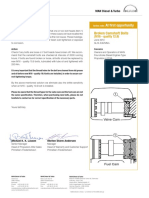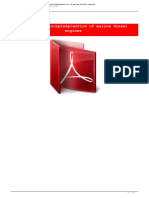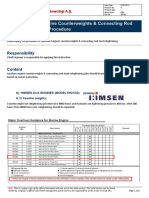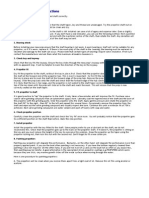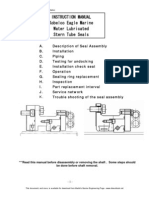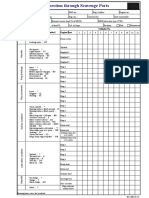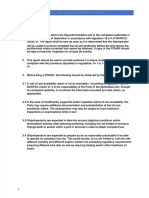Propeller Singing
Propeller Singing
Uploaded by
Him SatiCopyright:
Available Formats
Propeller Singing
Propeller Singing
Uploaded by
Him SatiOriginal Description:
Copyright
Available Formats
Share this document
Did you find this document useful?
Is this content inappropriate?
Copyright:
Available Formats
Propeller Singing
Propeller Singing
Uploaded by
Him SatiCopyright:
Available Formats
1Do Propellers Sing?
Yes, sometimes they sing: Some propellers in service produce a high-pitched noise, often referred to
as Singing. This sound typically is a clear harmonic tone much like a humming or ringing wine glass.
More of an annoyance than anything harmful, the causes of singing are not completely understood.
Many theories have been put forward to account for the phenomenon of Singing, but it appears to be
affected by critical factors for which the theories make no allowance. For instance, in some cases
when a twin-screw vessel has one propeller that sings, the noise is eliminated just by switching
position of propellers. Or had been replaced by an identical spare Propellers which were found
silent. Also the less number of blades the less cases of "singing".
Mitigation of Singing: Antisinging Edge
The singing is in function of propeller diameter and Rpm's, Boat speed and Trailing-edge size
(thickness) and roundness. In most of the cases not much can be done on Diameter, Rpm's or speed,
but we can modify the Edge Geometry. This has been the Strategy for all efforts to eliminate singing
Most Propeller professionals (and others) are familiar with the Antisinging Edge – a Chamfering of
the Trailing edge, typically on the Suction side. The intent of this shape is to avoid the creation of
curving flow eddies by cleanly separating the flow off of the blade.
The following graphic shows the Chamfering that goes from a 0.5 or 0.4 Radius to the tip of Suction
Side.
However the adoption of unduly thin edges can result in erosion or fracture of the blade near the
edges, it is advised that Antising Edge may be considered as a last resort to minimize the Singing of
an existing Propeller.
You might also like
- Woodward Ug-8 PDFDocument40 pagesWoodward Ug-8 PDFHim Sati86% (14)
- Sweep TSTDocument12 pagesSweep TSTanon_643160229No ratings yet
- SKF CouplingDocument16 pagesSKF CouplingmatchutNo ratings yet
- POP Ring - Serviceletter - LL2012-13Document4 pagesPOP Ring - Serviceletter - LL2012-13Андрей АндреевичNo ratings yet
- Broken Camshaft BoltsDocument1 pageBroken Camshaft BoltsAnakin SkywalkerNo ratings yet
- Prediction and Measurement of Propeller Singing: C e C Ec e EeDocument1 pagePrediction and Measurement of Propeller Singing: C e C Ec e EeArun SNo ratings yet
- DK Sanyal Principlespractice of Marine Diesel Engines: Book Read / Download OnlineDocument10 pagesDK Sanyal Principlespractice of Marine Diesel Engines: Book Read / Download OnlineLibin RajaNo ratings yet
- Installation Guidelines NHP2 & 4Document5 pagesInstallation Guidelines NHP2 & 4AlexDor100% (1)
- TI 42 - Auxiliary Engine Counterweights & Connecting Rod Stud Retightening ProcedureDocument11 pagesTI 42 - Auxiliary Engine Counterweights & Connecting Rod Stud Retightening ProcedurealoordominicNo ratings yet
- Refit Requirement - Fares1Document35 pagesRefit Requirement - Fares1boen jaymeNo ratings yet
- sl2019 685Document3 pagessl2019 685avm4343No ratings yet
- Parami METC: Alpha Lubricator Alpha ACCDocument5 pagesParami METC: Alpha Lubricator Alpha ACCHtet Wai Yan AungNo ratings yet
- Propeller Fitting InstructionsDocument7 pagesPropeller Fitting Instructionsrubens0001No ratings yet
- Economiser Energy Control For Increased Service Steam Production EngDocument20 pagesEconomiser Energy Control For Increased Service Steam Production EngSwayam JeetNo ratings yet
- General Installation, Operation, Maintenance and Troubleshooting Manual FOR Imo Pump Two Screw ProductsDocument24 pagesGeneral Installation, Operation, Maintenance and Troubleshooting Manual FOR Imo Pump Two Screw ProductsJulio C. Sivira CallejaNo ratings yet
- New Stuffing Box Ring Pack: Service Letter SL2013-579/KQRDocument1 pageNew Stuffing Box Ring Pack: Service Letter SL2013-579/KQRAKINMOLADUN OMOLADENo ratings yet
- Semi Spade Rudder CracksDocument3 pagesSemi Spade Rudder Crackslitos_92No ratings yet
- Stuffing Box - 7971-2205-0001Document2 pagesStuffing Box - 7971-2205-0001navaho2005No ratings yet
- Eexi MEPC76-15-Add2 Annex9Document10 pagesEexi MEPC76-15-Add2 Annex9SYAMiLLiONNo ratings yet
- Design and Analysis of Contra-Rotating Propeller BladeDocument27 pagesDesign and Analysis of Contra-Rotating Propeller BladeRaghavendra Raghav100% (2)
- Shaft Earthing ''BAC''Document17 pagesShaft Earthing ''BAC''AlexDorNo ratings yet
- Ccai Engine ManDocument12 pagesCcai Engine ManginanjarNo ratings yet
- Analysis of Ship Hull Girder VibrationDocument10 pagesAnalysis of Ship Hull Girder VibrationLucas Barrozo BrunNo ratings yet
- Octamar HF 10 Plus PDSDocument2 pagesOctamar HF 10 Plus PDSPaing100% (1)
- Himsen H17-28 - Instruction Book - Vol.2Document431 pagesHimsen H17-28 - Instruction Book - Vol.2swiatekpiotrwp.plNo ratings yet
- Lagersmit Supreme SealsDocument6 pagesLagersmit Supreme SealsAdi MuhibNo ratings yet
- Engine Indicators: OutlineDocument7 pagesEngine Indicators: Outlinechristianvan100% (1)
- Instruction Manual Box Cooler 156397Document20 pagesInstruction Manual Box Cooler 156397serNo ratings yet
- RTA-08 Cylinder Liners and Reinforced Water Guide JacketsDocument13 pagesRTA-08 Cylinder Liners and Reinforced Water Guide JacketsCatalin CataNo ratings yet
- Iso 1964 1987Document11 pagesIso 1964 1987Dina ANDRIAMAHEFAHERYNo ratings yet
- HMT-1000 中航鼎衡 fDocument197 pagesHMT-1000 中航鼎衡 fTammy Jim TanjutcoNo ratings yet
- 2007 Kobelco Stern Tube Seal Installation ManualDocument18 pages2007 Kobelco Stern Tube Seal Installation Manualvjmariner100% (2)
- 7S60ME-C8.5 - 105.0 - RPM - 14400 - KW - HL Full ReportDocument10 pages7S60ME-C8.5 - 105.0 - RPM - 14400 - KW - HL Full ReportAnonymous dUXvWL61No ratings yet
- Hans Jensen Lubricator Manual Type 6Document25 pagesHans Jensen Lubricator Manual Type 6David DiazNo ratings yet
- Anchor Study MaterialDocument10 pagesAnchor Study MaterialSunil S I ShippingNo ratings yet
- Pump Macb 531Document28 pagesPump Macb 531YULIANo ratings yet
- 3 ORB Cheat Sheet Mar 2017 RedDocument20 pages3 ORB Cheat Sheet Mar 2017 RedAntonNo ratings yet
- Sperre HL2 90Document1 pageSperre HL2 90Eslam MamdouhNo ratings yet
- CASTROL Lub Oil ChartDocument15 pagesCASTROL Lub Oil ChartHüseyin Gökhan PehlivanNo ratings yet
- Inspection Through Scavenge PortsDocument1 pageInspection Through Scavenge PortsValeriy DomashenkoNo ratings yet
- Hellenic Eng Soc Uk Nov2011Document79 pagesHellenic Eng Soc Uk Nov2011AmmarNo ratings yet
- Extra First Class COC Courses (Part B')Document11 pagesExtra First Class COC Courses (Part B')Rohit SethNo ratings yet
- Tailshaft Condition Monitoring TCM - Notation - Guide-July12Document2 pagesTailshaft Condition Monitoring TCM - Notation - Guide-July12Marlon Alejandro Arboleda Tapia100% (1)
- RT-137 - A1 Onboard Repair Kits and Order NumbersDocument6 pagesRT-137 - A1 Onboard Repair Kits and Order Numbers郑开元No ratings yet
- Rudder Carrier WearDocument2 pagesRudder Carrier WearNAGENDRA KUMAR DNo ratings yet
- MT Mosunmola Stern Tube Seal Service Report FinalDocument10 pagesMT Mosunmola Stern Tube Seal Service Report FinalNevzat AlkoçNo ratings yet
- EGF How To Check The ValveDocument6 pagesEGF How To Check The ValvenopaNo ratings yet
- Taiko 2MF - E PumpDocument2 pagesTaiko 2MF - E PumpAmit ChourasiaNo ratings yet
- MgpsDocument2 pagesMgpsSumeet SawantNo ratings yet
- PDF Fonar Fuel Oil Non Availability Report CompressDocument4 pagesPDF Fonar Fuel Oil Non Availability Report CompressAbhishek SharmaNo ratings yet
- MarineDocument21 pagesMarineAsm FaysalNo ratings yet
- Types and Causes of Engine Room AccidentsDocument3 pagesTypes and Causes of Engine Room AccidentsАлександр КармалитаNo ratings yet
- Taiko Kikai EMCN - E - CentrifugeDocument2 pagesTaiko Kikai EMCN - E - CentrifugeMakNo ratings yet
- Nfv-Bilge Water Separator PPT - BWS 10000: Operator ManualDocument16 pagesNfv-Bilge Water Separator PPT - BWS 10000: Operator ManualAnbarasan AnandhanNo ratings yet
- LR - Class - News - 02.2022 MARPOL Ann VI Fuel Oil Sampling PointDocument3 pagesLR - Class - News - 02.2022 MARPOL Ann VI Fuel Oil Sampling PointTomas CasisNo ratings yet
- Propeller Shaft-Coupling BoltsDocument2 pagesPropeller Shaft-Coupling BoltsSai Sarihaddu100% (1)
- Deck SealDocument7 pagesDeck SealAlamin Siddique100% (1)
- Ship Construction 1-PPTPDFDocument22 pagesShip Construction 1-PPTPDFafifrhmxNo ratings yet
- Boat Propeller & Propulsion Terminology: DiameterDocument7 pagesBoat Propeller & Propulsion Terminology: DiameterDominic VillamanteNo ratings yet
- Propeller & Propulsion TerminologyDocument4 pagesPropeller & Propulsion TerminologyjmvNo ratings yet
- Precautions Against CapsizingDocument1 pagePrecautions Against CapsizingHim SatiNo ratings yet
- Engine RT-flex Practical & Operation Advanced (5 Days) - Tailor Made (Rev1)Document7 pagesEngine RT-flex Practical & Operation Advanced (5 Days) - Tailor Made (Rev1)Him SatiNo ratings yet
- Awareness About Global Warming 1Document4 pagesAwareness About Global Warming 1Him SatiNo ratings yet
- ME Vs FlexDocument2 pagesME Vs FlexHim SatiNo ratings yet
- JANUARY 2017: SECTION - 1: Answer at Least TWO Questions SECTION - 2: Answer at Least TWO QuestionsDocument2 pagesJANUARY 2017: SECTION - 1: Answer at Least TWO Questions SECTION - 2: Answer at Least TWO QuestionsHim SatiNo ratings yet
- The Greenhouse EffectDocument5 pagesThe Greenhouse EffectHim SatiNo ratings yet
- Set 2, Mar 20Document8 pagesSet 2, Mar 20Him SatiNo ratings yet
- Surveyor Guide Notes On Tail Shaft Survey: 1. Propeller Shafts 1.1 Propeller Shaft Clearances - MeasurementDocument9 pagesSurveyor Guide Notes On Tail Shaft Survey: 1. Propeller Shafts 1.1 Propeller Shaft Clearances - MeasurementHim SatiNo ratings yet
- ME Vs FlexDocument2 pagesME Vs FlexHim SatiNo ratings yet
- CC Relief DoorDocument7 pagesCC Relief DoorHim SatiNo ratings yet
- Exam PapersDocument6 pagesExam PapersHim SatiNo ratings yet
- AC PowerDocument4 pagesAC PowerHim SatiNo ratings yet
- Motor Set 2Document8 pagesMotor Set 2Him SatiNo ratings yet
- MEP Set 2Document10 pagesMEP Set 2Him SatiNo ratings yet
- General Set 1Document10 pagesGeneral Set 1Him SatiNo ratings yet
- New Doc 13Document6 pagesNew Doc 13Him SatiNo ratings yet
- Electrical Set 2Document17 pagesElectrical Set 2Him SatiNo ratings yet
- Naval Set 1Document13 pagesNaval Set 1Him SatiNo ratings yet
- Galvanic SeriesDocument1 pageGalvanic SeriesHim SatiNo ratings yet
- Signum Oil Analysis Condition Monitoring Fundamentals English UkDocument20 pagesSignum Oil Analysis Condition Monitoring Fundamentals English UkHim SatiNo ratings yet
- Operational Information Bearing MaterialsDocument2 pagesOperational Information Bearing MaterialsHim SatiNo ratings yet
- Search: Marine EnginDocument4 pagesSearch: Marine EnginHim SatiNo ratings yet
- Specific Fuel Oil Consumption (SFOC) Definition, Formula and CalculationDocument3 pagesSpecific Fuel Oil Consumption (SFOC) Definition, Formula and CalculationHim Sati100% (2)
- 24 Answers: Related QuestionsDocument7 pages24 Answers: Related QuestionsHim SatiNo ratings yet




